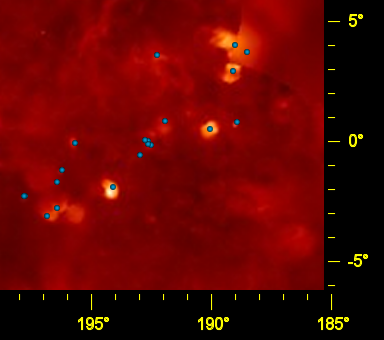
Hover your mouse over each blue dot for the name of the object, or click on the dot for a detail page. This map was created using the all-sky hydrogen-alpha map produced by Douglas Finkbeiner from data collected by the WHAM, VTSS and SHASSA hydrogen-alpha surveys.
Many of the nebulae on this image are connected to the Gemini OB1 asscociation and the 320 thousand solar mass complex of molecular clouds near and around that association, which lie at a distance of 1500 to 2000 parsecs.
Floating well above the galactic plane, the Jellyfish region is visible on the upper right of this image and is associated with some of the core stars of the Gem OB1 association. It contains the 3000-year-old Jellyfish supernova remnant SNR 189.1+03.0 (IC 443, Sh 2-248) at 1500 parsecs, and the HII regions Sh 2-249 at 1600 parsecs and and BFS 51 at 1800 parsecs. Also part of this complex is the reflection nebula vdB 75, the molecular cloud [KOY98] 102, and a second supernova remnant, SNR 189.6+3.3, which is visible in front of IC 443.
Below the Jellyfish region and near the galactic plane is the Monkey's Head nebula (Sh 2-252), which is ionised by the star cluster NGC 2175. Sh 2-252 is connected by CO filaments to nearby Sh 2-247 - both are embedded in the main body of the Gemini molecular clouds.
To the left of the Jellyfish region is the HII region Sh 2-253 at 4400 parsecs. Below this and to the left of the Monkey's Head region is a complex of 5 related HII regions embedded in a 27 thousand solar mass molecular cloud located at a distance of 2000 parsecs: Sh 2-254, Sh 2-255, Sh 2-256, Sh 2-257 and Sh 2-258. Just to the north at 2200 parsecs and probably part of the same complex is BFS 52. Just to the south but much further away at 8300 parsecs is Sh 2-259.
The brightest nebula on the left side of the image is Lower's nebula (Sh 2-261) at 1000 parsecs, which appears to be ionised by the O7.5V runaway star HD 41997. The other prominent nebula on the left side of the image appears to be associated with Sh 2-268 at 1300 parsecs. Visible next to Sh 2-268 but much further away is Sh 2-270 at 6800 parsecs. The faint nebula north of these objects is Sh 2-266, which may be a ring nebula surrounding its central star, the Be class supergiant MWC 137. In between Sh 2-268 and Sh 2-266 is Sh 2-267 at 4500 parsecs, and Sh 2-269 at 3800 parsecs, which is embedded in a 8700 solar mass molecular cloud.
The nebula on the far left of this image is Sh 2-271 at 4800 parsecs. There is a difference of opinion in the scientific literature about whether this object is an HII region or a planetary nebula.
